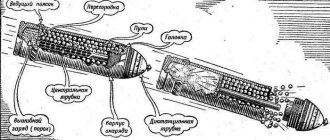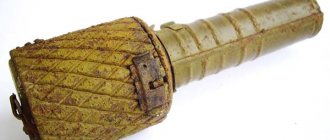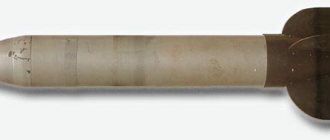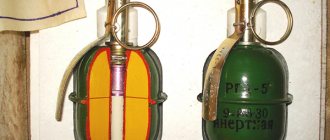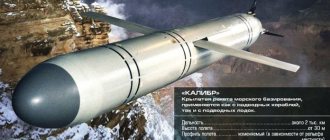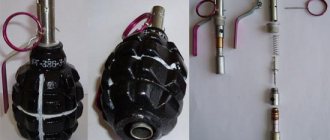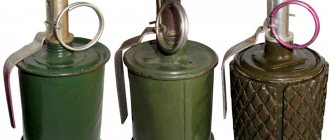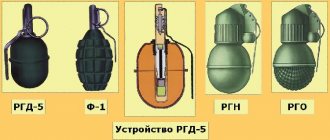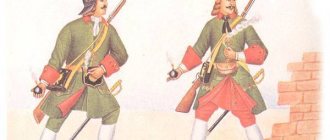War
Humanity has been at war almost throughout its entire existence. In ancient and modern history there has not been a single century that passed without one or another war. And unlike animals or our humanoid ancestors, people exterminate each other for various reasons, and not just for the sake of banal living space. Religious and political strife, racial hatred and so on. With the growth of technological progress, methods of warfare changed greatly, and the bloodiest ones began precisely after the invention of gunpowder and firearms.
At one time, even primitive muskets and cannons firing shotguns significantly changed combat methods and tactics. Simply put, they put an end to the era of chivalry with its armor and long battles. After all, what's the point of carrying heavy armor if it doesn't protect you from a rifle bullet or cannonball?
For a long time, gunsmiths tried to improve the design of guns, but this only happened in the second half of the 19th century, when artillery shells became unitary and barrels became rifled. But it was shrapnel that made the real technological breakthrough in the field of artillery ammunition. What it is and how such projectiles are designed, we will analyze in the article.
Definition
Shrapnel is a special type of cannon projectile that is designed to hit and destroy enemy personnel. It received its name in honor of its inventor, British officer Henry Shrapnel. The main and distinctive feature of such ammunition was that it exploded at a given distance and showered enemy forces not with fragments of the shell, but with hundreds of steel balls that scattered in a cone, directed with the wide part towards the ground - this is precisely shrapnel. We now know what it is, but we will consider in more detail the design features and history of the creation of such ammunition.
Story
At a time when gunpowder artillery became widespread, one of its shortcomings became very clear - the cannonball fired at the enemy did not have sufficient destructive factors of a mass nature. Usually it killed only one or a few people. They tried to partially correct this by loading the cannons with buckshot, but in this case its flight range greatly decreased. Everything changed when shrapnel began to be used. We already know what it is, but let’s look at the design itself in more detail.
Initially, such a projectile was a cylindrical box made of wood, cardboard or thin metal, inside which steel balls and a powder charge were placed. Then a ignition tube filled with slow-burning gunpowder was inserted into a special hole, which was set on fire at the moment of the shot. Simply put, it was a primitive fuse-moderator, and by adjusting the length of the tube, it was possible to calculate the height and range at which the projectile would explode and release its destructive elements onto the enemy. Thus, we have examined the question of what shrapnel means.
This type of projectile quickly proved its effectiveness. After all, now it was not necessary to hit anyone at all, the main thing was to calculate the length of the ignition tube and the distance, and then the steel buckshot would do its job. The year of invention of shrapnel is considered to be 1803.
Death in the open air
At the beginning of August 1914, the batteries of the first division of the 27th artillery brigade opened fire on open German artillery positions. Then, in a few minutes, the gun crews were destroyed, which forced the infantry of the German army to retreat. The soldiers of the Russian Empire then went on the attack and were able to capture twelve guns. One more example. In the same year, on August 7, the sixth battery of the forty-second French regiment opened fire with shrapnel shells from its cannons at the dragoon formation of the German army. Then it took only 16 shots to kill and wound approximately 700 people.
Rifled guns
However, despite all the effectiveness of destroying manpower with new types of shells, they were far from perfect. The length of the ignition tube must be calculated very accurately, as well as the distance to the enemy; they often misfired due to different compositions of gunpowder or its defects, sometimes exploding prematurely or not igniting at all.
Then in 1871, artilleryman Shklarevich, based on the general principle of shrapnel shells, made a new type of them - unitary and for rifled guns. Simply put, such an artillery shell of the “shrapnel” type was connected to a powder seed through a cartridge case and loaded through the breech of the gun. In addition, inside it was a new type of fuse that did not misfire. And the special shape of the projectile ejected spherical bullets strictly along the flight axis, and not in all directions, as before.
True, this type of ammunition was not without its drawbacks. The main thing was that the burning time of the fuse could not be adjusted, which meant that the artillery crew had to carry different types of fuse with them for different distances, which was very inconvenient.
Shrapnel: the shell that changed artillery
Russian 48-line (122 mm) shrapnel projectile
It is not for nothing that artillery is called the god of war, but this capacious definition still had to be earned. Before becoming the decisive argument of the warring parties, artillery went through a long development path. In this case, we are talking not only about the development of the artillery systems themselves, but also about the development of the artillery ammunition used.
A big step forward in increasing the combat capabilities of artillery was the invention of British officer Henry Shrapnel. He created a new ammunition, the main purpose of which was to combat enemy personnel. It is curious that the inventor himself did not witness the triumph of his brainchild, but he saw the beginning of the use of new ammunition in combat conditions.
Henry Shrapnel became the creator of a shell that brought artillery to a new level of its power. Thanks to shrapnel, artillery was able to effectively fight infantry and cavalry located in open areas and at a considerable distance from the guns. Shrapnel became steel death over the battlefield, hitting troops in marching columns, at moments of rebuilding and preparing for an attack, and at rest stops. At the same time, one of the main advantages was the range of use of ammunition, which buckshot could not provide.
Henry Shrapnel
Henry Shrapnel, whom descendants began to call “the killer of infantry and cavalry,” began creating new artillery ammunition at the end of the 18th century. The British Army officer's idea was to combine two types of already known shells in a new weapon - a bomb and buckshot. The first ammunition was a hollow cannonball filled with gunpowder and equipped with a ignition tube. The second was a set of metal striking elements that were placed in a bag, or, at later stages of development, in a cardboard, cylindrical metal package.
Shrapnel's idea was to combine the destructive power of these two ammunitions; from the bomb, he wanted to borrow the radius of destruction and the power of the explosion, and from buckshot, the lethal effect of defeating openly positioned enemy infantry and cavalry.
The birthplace of shrapnel can be called Gibraltar, where Lieutenant of the British Royal Artillery Henry Shrapnel was assigned in 1787 . Here the inventor not only served, but also seriously studied the experience of the Great Siege of Gibraltar (1779-1783), mainly the use of artillery by the warring parties. Just six months after arriving at the fortress, the lieutenant demonstrated his brainchild to the commander of the British garrison.
The date of the first experiment using shrapnel is December 21, 1787. The weapon used was an 8-inch mortar, which was loaded with a hollow core, inside of which were placed approximately 200 musket balls and the gunpowder necessary for the explosion. They shot from the fortress towards the sea from a hill approximately 180 meters above the water level. The experiment was considered successful, the new ammunition exploded about half a second before hitting the water surface, the water literally boiled from being hit by hundreds of bullets.
The tests made a good impression on the officers present, including Major General O'Hara, but the commander of the Gibraltar garrison did not dare to take the implementation of the project under his personal patronage.
Shrapnel Buckshot Grenade
As a result, in 1795, Henry Shrapnel returned to the British Isles with ideas, the results of tests, but without the ammunition itself and the prospects for its production. Already at the rank of captain, he did not give up his idea and took up “the favorite activity of inventors” - active correspondence with all kinds of officials.
Continuing to improve the new ammunition, Henry Shrapnel prepared several reports to the Ordnance Council Commission. Here his papers lay motionless for several years, after which the inventor received a refusal to support his work. However, Shrapnel was not going to give up and literally bombarded the commission with his messages and proposals; after all, the artillery officer knew a lot about conducting good artillery preparation. As a result, in June 1803, the bureaucratic British monster fell under the attacks of a persistent officer; his messages received positive feedback.
Despite the fact that at that time the problem with premature detonation of ammunition had not been fully resolved, the results of tests conducted in England were considered successful and encouraging. The new artillery shell was included in the approved list of ammunition for British field troops, and Henry Shrapnel himself was promoted on November 1, 1803, receiving the rank of artillery major.
The grapeshot grenade proposed by officer Henry Shrapnel was made in the form of a hollow, durable sphere, inside of which there was a charge of gunpowder, as well as a bullet. The main feature of the grenade proposed by the inventor was the hole in the body into which the ignition tube was placed. The ignition tube was made of wood and contained a certain amount of gunpowder. Such a tube served both as a moderator and an igniter.
When the gun was fired, while still in the barrel bore, the gunpowder ignited in the ignition tube. Gradually, while the projectile was flying towards its target, the gunpowder burned out; as soon as it burned out all, the fire approached the powder charge, which was located in the hollow body of the grenade itself, which led to the explosion of the projectile. The effect of such an explosion is easy to imagine; it led to the destruction of the grenade body, which in the form of fragments along with bullets scattered to the sides, hitting the enemy infantry and cavalry.
A special feature of the new projectile was that the length of the ignition tube could be adjusted by the gunners themselves before firing . Thanks to this solution, it was possible to achieve a grenade explosion at the desired time and in the desired place with an acceptable level of accuracy at that time.
Charge of a light horse brigade under Russian artillery fire
The brainchild of Henry Shrapnel was first tested in real combat conditions on April 30, 1804. The debut of the new projectile occurred during the attack on Fort New Amsterdam, located on the territory of Dutch Guiana (Suriname). Major William Wilson, who led the British artillery in that battle, later wrote that the effect of the new shrapnel shells was amazing. The garrison of New Amsterdam decided to capitulate after the second salvo; the Dutch were amazed that they were suffering losses from musket bullets at such a great distance from the enemy.
It should be noted here that smoothbore guns of that era could effectively fire buckshot at a range of 300-400 meters, while the cannonballs flew at a distance of up to 1200 meters, the same was true for smoothbore guns, the firing range of which was limited to 300 meters. In the same 1804, Shrapnel was promoted to lieutenant colonel; later this artillery officer and inventor successfully rose to the rank of general and even received a salary from the British government in the amount of 1,200 pounds per year (a very serious sum of money at that time), which also indicates for recognition of his merits.
And shrapnel became increasingly widespread. In January 1806, the new ammunition brought death and terror to the enemies of the British in southern Africa, where the empire on which the sun never set was regaining control of the Cape Colony, after which the new projectile was used in India, and in July 1806 at the Battle of Maida . The new artillery ammunition quickly took its place in the sun and was increasingly used in battles around the world every year.
The original British invention eventually became widespread in the armies of all countries. One example of the successful use of shrapnel is the famous “light cavalry charge” during the Crimean War of 1853-1856. The witness of the battle, General Pierre Bosquet of the French Army, described it best of all in his time: “It’s great, but it’s not war: it’s madness.” One can only agree with the French general that the attack of the English light cavalry brigade, commanded by Lord Cardigan, went down in history. Poems, paintings, and then films were dedicated to this event.
The attack itself at Balaklava, under fire from Russian artillery, which used shrapnel, and riflemen positioned on the heights dominating the terrain, cost the British the loss of approximately half of the brigade's personnel and even more horses.
Diaphragm shrapnel projectile
It is worth noting that it was Russian artillerymen who made a significant contribution to the improvement of ammunition. The Russian Empire found its own Henry Shrapnel, his place was taken by the Russian artillery scientist Vladimir Nikolaevich Shklarevich . After rifled guns had just begun to appear in the armies of the world, Vladimir Shklarevich introduced a new type of projectile - diaphragm shrapnel with a central tube and a bottom chamber, this happened in 1871.
The presented ammunition looked like a cylindrical body; it was divided into two compartments by a diaphragm (cardboard partition). An explosive charge was placed in the bottom compartment of Shklarevich’s projectile. The other compartment contained spherical bullets. Along the axis of the projectile there was a central tube, which was filled with a pyrotechnic composition. A head with a primer was placed on the front of the projectile. After firing from the gun, the capsule exploded and the slow-burning pyrotechnic composition ignited in the longitudinal tube.
During the flight, the fire passed through the tube and reached the powder charge in the bottom compartment, which led to the explosion of the projectile. The resulting explosion pushed the diaphragm forward along the flight of the projectile, as well as the bullets behind it, which flew out of the projectile. A new scheme proposed by a Russian engineer made it possible to use ammunition in modern rifled artillery.
The new projectile also had its own significant advantage. Now, when a shell was detonated, the bullets scattered not evenly in all directions, as originally happened when a spherical grenade of the Shrapnel design was detonated, but directed along the axis of flight of the artillery shell with a deviation to the side from it. This solution increased the combat effectiveness of artillery fire when firing shrapnel.
The presented design also had a significant drawback, but it was quickly eliminated. Shklarevich's first projectile provided for firing only at a predetermined distance. The shortcoming was eliminated already in 1873, when a remote detonation tube for a new ammunition with a rotating ring was created. The main difference was that now from the primer to the demolition charge the fire followed a path consisting of three parts. One part, as before, was the central tube, and the remaining two sections were channels with the same pyrotechnic composition, but located in rotary rings. By turning these rings, artillerymen could change the amount of pyrotechnic composition, ensuring the detonation of shrapnel at the required distance during the battle.
At the same time, two terms appeared in the colloquial speech of artillery crews: the projectile was placed “on shrapnel” , if it was necessary for it to explode at a great distance from the gun, and “on buckshot” , if the remote tube was adjusted for a minimum burning time. The third option for using such projectiles was the “on impact” , when the path from the primer to the demolition charge was completely blocked. In this position, the projectile exploded only at the moment it met an obstacle.
The use of shrapnel shells reached its peak at the beginning of the First World War. As experts note, for field and mountain artillery of 76 mm caliber, such shells made up the vast majority of ammunition. At the same time, shrapnel was quite actively used by large-caliber artillery systems. For example, about 260 bullets were placed in a 76-mm projectile, and about 600 in a 107-mm projectile.
In the event of a successful rupture, such a deadly swarm of lead could cover an area 20-30 meters wide and up to 150-200 meters deep - almost a third of a hectare. With a successful explosion, just one shrapnel could cover a section of the high road along which a company of 150-200 people was moving in a column along with their machine-gun gigs.
One of the most effective uses of shrapnel shells occurred at the beginning of the First World War. On August 7, 1914, Captain Lombal, commander of the 6th battery of the 42nd regiment of the French army, during the outbreak of the battle, was able to detect in time, at a distance of five kilometers from the location of his guns, German troops who had emerged from the forest. Fire was opened at the concentration of troops with shrapnel shells from 75-mm guns; the 4 guns of its battery fired a total of 16 shots.
The result of the shelling, which caught the enemy at the moment of restructuring from marching to combat formations, turned out to be catastrophic for the Germans. As a result of the artillery strike, the 21st Prussian Dragoon Regiment lost only about 700 people killed and approximately the same number of trained horses; after such a strike, the regiment ceased to be a combat unit.
Combat during the First World War
But by the middle of the First World War, when the parties switched to positional actions and the massive use of artillery, and the quality of the officers of the warring sides fell, the disadvantages of shrapnel began to appear. Among the main disadvantages were:
- the small lethal effect of spherical shrapnel bullets (usually quite low-grade), they could be stopped by any obstacle;
- powerlessness against targets hidden in trenches, trenches (with a flat firing trajectory), dugouts and caponiers (with any trajectory);
- low effectiveness of long-range fire when using poorly trained officers, especially reservists;
- small destructive effect against enemy material, even openly located.
- the greater complexity and high cost of such ammunition.
For these reasons, even during the First World War, shrapnel was gradually replaced by a fragmentation grenade with an instantaneous fuse, which did not have the listed disadvantages and, moreover, had a great psychological impact on enemy soldiers.
Gradually, the number of shrapnel in the troops decreased, but even during the Second World War, such ammunition was used quite en masse, as search engines working at battle sites can tell you. And the very use of shrapnel shells is reflected in fiction, for example, the famous story “Volokolamsk Highway”.
In the second half of the 20th century, the shrapnel shell, which had been a real threat to infantry for more than a century, practically ceased to be used, but the very ideas on which this weapon was based, albeit in a modified version, continue to be used today at a new level of development of science and technology.
/Sergey Yuferev, topwar.ru/
Source
Adjustable detonation
This was corrected in 1873, when a blast tube with a rotary adjustment ring was invented. Its meaning was that divisions were applied to the ring, indicating the distance. For example, if it was necessary to detonate a projectile at a distance of 300 meters, then the fuse was turned to the appropriate division using a special key. And this greatly facilitated the conduct of combat, because the marks coincided with the notches in the artillery sight, and no additional instruments were required to determine the range. And if necessary, by setting the projectile to the minimum detonation time, the cannon could be fired like a grapeshot. There was also an explosion from hitting the ground or other obstacle. You can see what shrapnel looks like in the photo below.
Usage
Such shells were used from the very beginning of their invention until the end of the First World War. Despite their advantages over the old solid shells, over time it became clear that shrapnel also had disadvantages. For example, its destructive elements were powerless against enemy soldiers who were hiding in trenches, dugouts and generally any shelters. And poorly trained artillerymen often set the wrong firing time for the fuse, and this type of shell, such as shrapnel, was expensive to produce. We figured out what it is.
Therefore, after the First World War, shrapnel was completely replaced by fragmentation shells with an impact fuse.
But in some types of weapons it was still used, for example in the German bouncing mine Sprengmine 35 - at the moment of activation, the expelling charge pushed a “glass” filled with spherical bullets to a height of about one and a half meters, and it exploded.
Development of the idea
Although shrapnel shells are practically no longer used as anti-personnel weapons, the ideas on which the design of the projectile was based continue to be used:
- Ammunition with a similar design principle is used, in which rod, arrow-shaped or bullet-shaped striking elements are used instead of spherical bullets. In particular, during the Vietnam War, the United States used howitzer shells with striking elements in the form of small steel feathered arrows. These shells showed their high efficiency in the defense of gun positions. There is also ammunition for anti-aircraft artillery in the form of containers with ready-made submunitions, some types of which can open before contact with the target when the fuse is triggered, forming a cloud of gas.
- The warheads of some anti-aircraft missiles are built on the principles of a shrapnel projectile. For example, the warhead of S-75 air defense missiles is equipped with ready-made striking elements in the form of steel balls or, in some modifications, pyramids. The weight of one such element is less than 4 g, the total number in the warhead is about 29 thousand.
